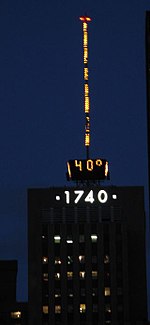888 Seventh Avenue

888 Seventh Avenue is a 628 ft (191m) tall modern-style office skyscraper in Midtown Manhattan which was completed in 1969 and has 46 floors. Emery Roth & Sons designed the building. 888 Seventh Avenue is "L"-shaped in plan, with wings extending north to 57th Street and east to Seventh Avenue, around the adjacent Rodin Studios. It currently carries the Vornado Realty Trust corporate headquarters. Previously known as the Arlen Building, it had been named for the company responsible for its construction, Arlen Realty & Development Corporation. The Red Eye Grill is located in the building at street level. Moed de Armas renovated the Lobby, Elevators & Plaza in 2006, cladding them with white marble. The HVAC was also extensively renovated and the building was later given gold certification by the Leadership in Energy and Environmental Design.
Excerpt from the Wikipedia article 888 Seventh Avenue (License: CC BY-SA 3.0, Authors, Images).888 Seventh Avenue
West 56th Street, New York Manhattan
Geographical coordinates (GPS) Address External links Nearby Places Show on map
Geographical coordinates (GPS)
| Latitude | Longitude |
|---|---|
| N 40.7652 ° | E -73.9808 ° |
Address
888 Seventh Avenue
West 56th Street 888
10019 New York, Manhattan
New York, United States
Open on Google Maps







